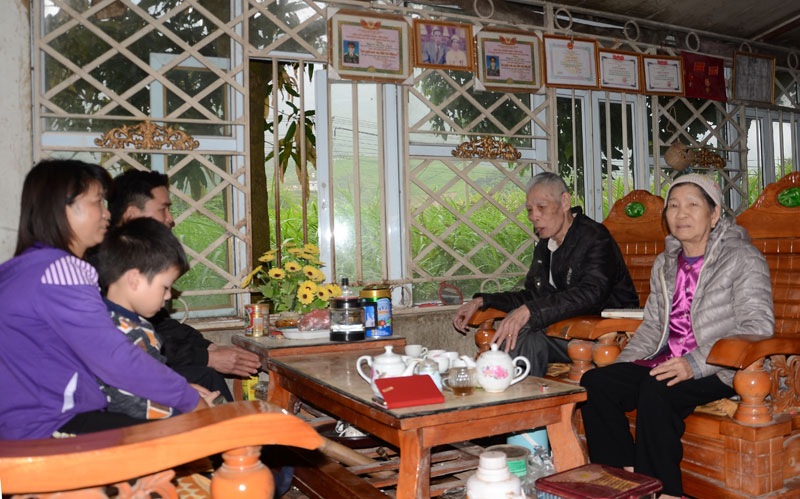
(HBO) – In 1965, when its special warfare strategy failed disastrously, the US sent large numbers of troops to the south of Vietnam while extending the war to the north and conducting sabotage. In Hoa Binh, which was viewed as one of the important localities for providing support for the Lao battlefield, during only a short period of time, the US conducted 69 bombings to destroy local residential areas, economic premises and roads.

Bui Van Kenh, a resident in
Tha hamlet of Thu Phong commune, who directly commanded the fight as deputy
head of the commune’s militia force.
In
particular, it launched continual attacks on locations across the province from
early 1966. To cope with new plots and ruses of the US imperialists, the province
ordered its communes to make plans for dealing with the war of sabotage,
instruct locals how to take shelter from air raids, dig tunnels, build lookout
towers, and stay ready to shoot down low-altitude fighters.
One of the most successful battles of the militia
of Thu Phong commune was the downing of an F105 fighter of the US on July 20,
1966.
Recalling the battle, Bui Van Kenh, a resident
in Tha hamlet of Thu Phong commune, who directly commanded the fight as deputy
head of the commune’s militia force, said he was on guard at the commune’s
administrative committee at about 3pm on July 20, 1966 when two F105 fighters
flew in from the northwest. Above Cun Slope on Road 12B, they dived and fired
at an automobile of the Hoa Binh transport company that was parking on the top
of the slope. Kenh immediately called on militias to move to the trench behind
a warehouse of the Nam Son Cooperative to ready the combat formation.
Observing the enemy fighters’ direction, Kenh
ordered the first volley to be fired, but the bullets missed their targets. The
militia team shortly learned from this and waited for the two aircraft to lower
to focus their attack on the front one. Braving a rain of bullets from the
enemy fighters, the militias still calmly waited for the planes to come within
the suitable range.
When the leading fighter just entered the right
range, under Kenh’s command, the team focused firing on it. Being hit by
bullets, the fighter burst into flames and crashed onto Cun Slope, causing a
big explosion that shook the entire mountain and forest, Doan Duc Tinh, a
member of the then Nam Son Cooperative’s militia team, recounted.
Not only being heroes in combat, the populace of
Thu Phong also helped safeguard many central agencies that evacuated to the
commune while actively working to ensure livelihoods and support the "great
front” in the south.
In peacetime, they have worked hard to develop
economy and enrich the homeland. In 2019, the local per capita income
approximated 31 million VND (over 1,300 USD at the current exchange rate), and
the household poverty rate was brought down to 3.9 percent. The commune has met
all criteria for a new-style rural area while people’s cultural and spiritual
life has also been improved continually./.
Hoa Binh province is undergoing a dynamic transformation amid Vietnam’s national digital transition. Building on Poliburo’s Resolution No. 57-NQ/TW on breakthroughs in science, technology, innovation, and national digital transformation, the province has rolled out a wide range of practical action plans. A standout initiative is the "Digital Literacy for All” movement, an effort to ensure that no one is left behind in the digital era.
Hoa Binh province is undergoing a dynamic transformation in the wake of the national digital transformation movement. Building on Resolution No. 57-NQ/TW of the Politburo on breakthroughs in science, technology, innovation, and national digital transformation, the province has implemented a wide range of practical action plans. A standout initiative is the "Digital Literacy for All” movement ambitious effort to ensure that no one is left behind in the digital age.
With a spirit of unity and proactive problem-solving, the Party Committee, the government and the people of Dong Lai Commune (Tan Lac District) have made great strides in implementing the resolutions of the 24th Party Congress of the commune for the 2020 - 2025 term. Focusing on leadership and practical actions, the commune has brought the Party’s resolutions into daily life, creating strong impacts and pushing the local development forward.
Amid the nationwide push for digital transformation, young people in Hoa Binh Province are stepping up as dynamic pioneers, applying technology to enhance Youth Union operations and expand the reach of youth-led initiatives. Through creativity and adaptability, Youth Union organizations at all levels have introduced a series of practical solutions, contributing to modern governance and community development.
In recent years, An Nghia commune, located in Lac Son district, has stepped up administrative reform, focusing on improving the quality and efficiency of its single-window service unit for receiving and processing administrative procedures. These improvements have helped create favourable conditions for local residents and organisations to handle administrative procedures, contributing to the commune’s broader socio-economic development.
The Prime Minister-approved master plan to develop the multi-use value of forests ecosystems through 2030, with a vision to 2050, aims to improve the management and sustainable use of forest resources, create jobs, increase incomes, and improve the living standards of ethnic minorities, people in mountainous and remote areas, forest workers and those living near forests.



